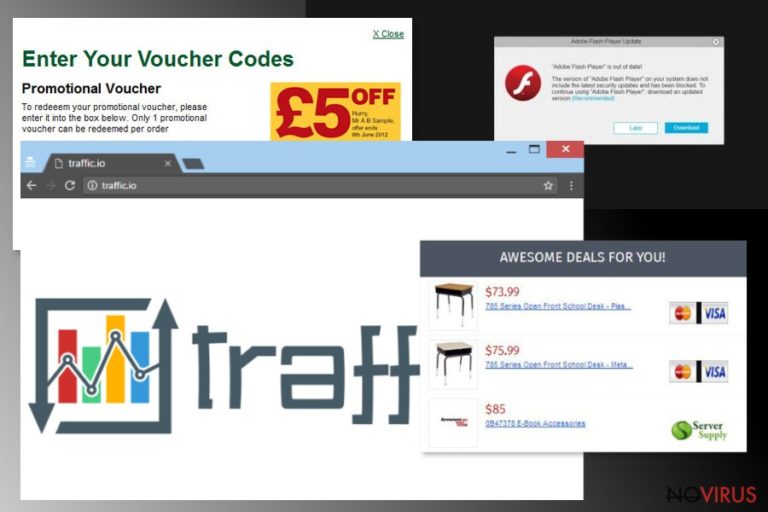Uninstall Traffic Exchange ads (Uninstall Guide) - Nov 2017 updated
Traffic Exchange ads Removal Guide
Description of Traffic Exchange virus
Traffic Exchange ads might disturb and annoy you while browsing the Internet

Traffic Exchange is known for its online advertising services. Users report that it continuously floods them with irritating ads that appear as banners, in-texts or pop-ups. Usually, it targets Google Chrome, Mozilla Firefox, Internet Explorer, and other famous browsers. Security experts classify it as an adware program similar to questionable traffic.io and online.io apps.
According to the reports, Traffic Exchange infiltrates specific browser extensions and/or cookies to monitor and collect browsing-related information. It may include IP addresses, geolocations or information that the user unconsciously provide by himself/herself.
For example, if you submit your personal information in the search bar, the PUP gathers it and may expose it to third-party companies that are related to the ad-supported program. Thus, we encourage you to never reveal your credentials in order to avoid severe privacy issues or even identity theft. In our professional opinion, you should remove Traffic Exchange as soon as you notice its presence.
It is easy to recognise it by an excessive amount of ads it displays. They are annoying and bothers you every time you launch your browser. We strongly suggest you not to click on those advertisements since they might redirect you to deeply suspicious sites. Delays in Traffic Exchange removal increase the risk of getting infected with other malware that might be distributed by employing deceptive ads.

Thus, you should get rid of Traffic Exchange immediately. Employ a professional anti-spyware application and free yourself from irritating ads displayed by the ad-supported program. Our cyber security experts offer FortectIntego and SpyHunter 5Combo Cleaner or any other reliable security software.
Adware travels in free app bundles
You can get infected with Traffic Exchange if you have recently downloaded third-party applications without monitoring the installation of it carefully. Developers are not entirely honest with computer users when it comes to the download/installation process.
In other terms, can unwillingly download it while installing freeware. Be extremely cautious — attentively follow the download/installation procedure and opt for Custom or Advances settings.
It will allow you to detect and unmark any pre-selected boxes permitting to install the adware. Be aware to always de-select them and avoid choosing Quick or Recommended options offered by dishonest developers.
While many might not know, potentially unwanted programs (PUPs) might also infiltrate on your computer via infected ads in unreliable sites. Despite how genuine they look, never click on them if you want to protect your system from high-risk computer infections.
Get help from a security software to get rid of Traffic Exchange ads
The fastest way to stop annoying advertisements from bothering you is to use a reputable anti-malware program to remove Traffic Exchange with ease. It is the wisest decision since you will decrease the risk of making a manual mistake — the only thing you need to do is to download it from verified developers and run a full system scan. The security software will identify the compromised data and get rid of the spyware within seconds.
However, if you still aim for a manual Traffic Exchange removal, our team has prepared a detailed guide provided at the end of this article. Remember that the manual elimination process is time-consuming. Thus, you have to attentively follow the steps and be patient.
You may remove virus damage with a help of FortectIntego. SpyHunter 5Combo Cleaner and Malwarebytes are recommended to detect potentially unwanted programs and viruses with all their files and registry entries that are related to them.
Getting rid of Traffic Exchange ads. Follow these steps
Uninstall Traffic Exchange in Windows systems
The instructions provided below will guide you through the entire removal process. Make sure to strictly follow them.
Terminate suspicious programs from Windows 10/8 machines by following these instructions:
- Type Control Panel into Windows search and once the result shows up hit Enter.
- Under Programs, choose Uninstall a program.

- Find components related to suspicious programs.
- Right-click on the application and select Uninstall.
- Click Yes when User Account Control shows up.

- Wait for the process of uninstallation to be done and click OK.
Windows 7/XP instructions:
- Click on Windows Start and go to Control Panel on the right pane.
- Choose Add/Remove Programs.

- Select Uninstall a program under Programs in Control Panel.
- Click once on the unwanted application.
- Click Uninstall/Change at the top.
- Confirm with Yes.
- Click OK and finish the removal.
Uninstall Traffic Exchange in Mac OS X system
-
Users who use OS X should click on Go button, which can be found at the top left corner of the screen and select Applications.

-
Wait until you see Applications folder and look for Traffic Exchange or any other suspicious programs on it. Now right click on every of such entries and select Move to Trash.

Delete Traffic Exchange ads from Microsoft Edge browser
Delete suspicious extensions from MS Edge:
- Go to the Menu by clicking on the three horizontal dots at the top-right.
- Then pick Extensions.

- Choose the unwanted add-ons on the list and click on the Gear icon.
- Click on Uninstall at the bottom.
Clear cookies and other data:
- Click on the Menu and from the context menu select Privacy & security.
- Under Clear browsing data, select Choose what to clear.

- Choose everything except passwords, and click on Clear.
Alter new tab and homepage settings:
- Click the menu icon and choose Settings.
- Then find On startup section.
- Click Disable if you found any suspicious domain.
Reset MS Edge fully:
- Click on the keyboard Ctrl + Shift + Esc to open Task Manager.
- Choose More details arrow at the bottom.
- Go to Details tab.

- Now scroll down and locate every entry with Microsoft Edge name in it.
- Right-click on each of them and select End Task to stop MS Edge from running.
When none of the above solves the issue, you might need an advanced Edge reset method, but you need to backup your data before proceeding.
- Find the following folder on the PC: C:\\Users\\%username%\\AppData\\Local\\Packages\\Microsoft.MicrosoftEdge_8wekyb3d8bbwe.
- Press Ctrl + A on your keyboard to select all folders.

- Right-click on the selection and choose Delete
- Right-click on the Start button and pick Windows PowerShell (Admin).

- Copy and paste the following command, and then press Enter:
Get-AppXPackage -AllUsers -Name Microsoft.MicrosoftEdge | Foreach {Add-AppxPackage -DisableDevelopmentMode -Register “$($_.InstallLocation)\\AppXManifest.xml” -Verbose
Instructions for Chromium-based Edge
Delete extensions:
- Open Edge and click Settings.
- Then find Extensions.

- Delete unwanted extensions with the Remove.
Clear cache and site data:
- Click on Menu and then Settings.
- Find Privacy and services.
- Locate Clear browsing data, then click Choose what to clear.

- Time range.
- Click All time.
- Select Clear now.
Reset Chromium-based MS Edge browser fully:
- Go to Settings.
- On the left side, choose Reset settings.

- Select Restore settings to their default values.
- Click Reset.
Delete Traffic Exchange from Mozilla Firefox (FF)
As mentioned above, the app is related to traffic.io and online.io. In order to eliminate the ad-supported program from your Mozilla Firefox browser, remove all extensions and add-ons that are linked to it.
Remove suspicious Firefox extensions:
- Open Mozilla Firefox browser and click on the three horizontal lines at the top-right to open the menu.
- Select Add-ons in the context menu.

- Choose plugins that are creating issues and select Remove.
Reset the homepage on the browser:
- Click three horizontal lines at the top right corner.
- This time select Options.
- Under Home section, enter your preferred site for the homepage that will open every time you launch Mozilla Firefox.
Clear cookies and site data:
- Click Menu and pick Options.
- Find the Privacy & Security section.
- Scroll down to choose Cookies and Site Data.

- Click on Clear Data… option.
- Click Cookies and Site Data, Cached Web Content and press Clear.
Reset Mozilla Firefox:
If none of the steps above helped you, reset Mozilla Firefox as follows:
- Open Mozilla Firefox and go to the menu.
- Click Help and then choose Troubleshooting Information.

- Locate Give Firefox a tune-up section, click on Refresh Firefox…
- Confirm the action by pressing on Refresh Firefox on the pop-up.

Chrome browser reset
To get rid of Traffic Exchange ads, search for any suspicious plug-ins and uninstall them. Shortly after you will be able to reset your Goggle Chrome browser and finally free yourself from annoying advertisements.
Find and remove suspicious extensions from Google Chrome:
- In Google Chrome, open the Menu by clicking three vertical dots at the top-right corner.
- Select More tools > Extensions.
- Once the window opens, you will see all the installed extensions.
- Find any suspicious add-ons related to any PUP.
- Uninstall them by clicking Remove.

Clear cache and web data from Chrome:
- Click the Menu and select Settings.
- Find Privacy and security section.
- Choose Clear browsing data.
- Select Browsing history.
- Cookies and other site data, also Cached images and files.
- Click Clear data.

Alter settings of the homepage:
- Go to the menu and choose Settings.
- Find odd entries in the On startup section.
- Click on Open a specific or set of pages.
- Then click on three dots and look for the Remove option.
Reset Google Chrome fully:
You might need to reset Google Chrome and properly eliminate all the unwanted components:
- Go to Chrome Settings.
- Once there, scroll down to expand Advanced section.
- Scroll down to choose Reset and clean up.
- Click Restore settings to their original defaults.
- Click Reset settings again.

Delete Traffic Exchange from Safari
Get rid of questionable extensions from Safari:
- Click Safari.
- Then go to Preferences…

- Choose Extensions on the menu.
- Select the unwanted extension and then pick Uninstall.
Clear cookies from Safari:
- Click Safari.
- Choose Clear History…

- From the drop-down menu under Clear, find and pick all history.
- Confirm with Clear History.
Reset Safari fully:
- Click Safari and then Preferences…
- Choose the Advanced tab.
- Tick the Show Develop menu in the menu bar.
- From the menu bar, click Develop.

- Then select Empty Caches.
Even if you have completed all the steps above, we still strongly recommend you to scan your computer system with a powerful anti-malware software. It is advisable to do that because an automatic malware removal tool can detect and delete all remains of Traffic Exchange, for instance, its registry keys. The anti-malware program can help you to easily detect and eliminate possibly dangerous software and malicious viruses in an easy way. You can use any of our top-rated malware removal programs: FortectIntego, SpyHunter 5Combo Cleaner or Malwarebytes.
How to prevent from getting adware
Prevent the government from spying on you
As there is a growing debate in government about collecting users' data and spying on citizens, you should take a closer look at this issue and find out what shady ways of gathering information can be used to collect information about you. You need to browse anonymously if you want to avoid any government-initiated spying and tracking of information.
You can enjoy secure internet browsing and minimize the risk of intrusion into your system if you use Private Internet Access VPN program. This VPN application creates a virtual private network and provides access to the required data without any content restrictions.
Control government and other third party access to your data and ensure safe web browsing. Even if you do not engage in illegal activities and trust your ISP, we recommend being careful about your security. You should take extra precautions and start using a VPN program.
Reduce the threat of viruses by backing up your data
Due to their own careless behavior, computer users can suffer various losses caused by cyber infections. Viruses can affect the functionality of the software or directly corrupt data on your system by encrypting it. These problems can disrupt the system and cause you to lose personal data permanently. There is no such threat if you have the latest backups, as you can easily recover lost data and get back to work.
It is recommended to update the backups in parallel each time the system is modified. This way, you will be able to access the latest saved data after an unexpected virus attack or system failure. By having the latest copies of important documents and projects, you will avoid serious inconveniences. File backups are especially useful if malware attacks your system unexpectedly. We recommend using the Data Recovery Pro program to restore the system.


